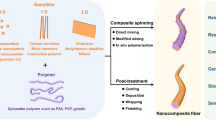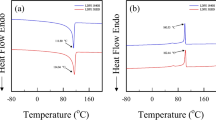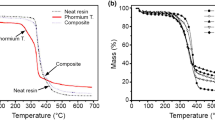Abstract
The introduction of carbon black in a polyamide matrix allows one to obtain conductive materials because of the formation of a filler network. Resulting electrical properties depend, among others, on the processing conditions. In a first part, we investigate the influence of mixing conditions (rotor speed, temperature, mixing time) on electrical conductivity. Then, in a second part, we try to characterize the conducting network by rheological measurements and to establish relationships between rheological parameters and electrical properties. For that purpose, we propose to perform successive strain sweep experiments at constant frequency, from 0.5 to 100%, then from 100 to 0.5%, and finally, again, from 0.5 to 100%. Between two successive strain sweeps, we observe a drop in the moduli values that can be attributed to the breakdown of the carbon black network. A clear relationship is established between rheological and electrical properties of the compounds. Moreover, we propose a presentation of the rheological data that permits to rank the samples according to the strength of the carbon black network.




















Similar content being viewed by others
References
Bar-Chaput S, Carrot C (2006) Rheology as a tool for the analysis of the dispersion of carbon filler in polymers. Rheol Acta 45:339–347
Bohin F, Manas-Zloczower I, Feke DL (1996) Kinetics of dispersion for sparse agglomerates in simple flows: application to silica agglomerates in silicone polymers. Chem Eng Sci 51:5193–5204
Boonstra BB (1977) Resistivity of unvulcanized compounds of rubber and carbon black. Rubber Chem Technol 50:194–210
Boonstra BB, Medalia IA (1963) Effect of carbon black dispersion on the mechanical properties of rubber vulcanizates. Rubber Chem Technol 36:115–142
Carmona F, Ravier J (2002) Electrical properties and mesostructure of carbon black-filled polymers. Carbon 40:151–156
Cassagnau P, Mélis F (2003) Non-linear viscoelastic behaviour and modulus recovery in silica filled polymer. Polymer 44:6607–6615
Cembrola RJ (1983) Resistivity and surface roughness analysis for evaluating carbon black dispersion in rubber. Rubber Chem Technol 56:233–245
Das NC, Chaki TK, Khastgir D (2002) Effect of processing parameters, applied pressure and temperature on the electrical resistivity of rubber-based conductive composites. Carbon 40:807–816
Feller JF, Petitjean E (2003) Conductive polymer composites (CPC): influence of processing conditions, shear rates and temperatures on electrical properties of poly(butylene terephtalate)/poly(amide12-b-tetramethyle-neglycol)–carbon black blends. Macromol Symp 203:309–315
Feller JF, Linossier I, Charpentier A (2002) Conductive polymer composites (CPC): influence of processing conditions, shear rate and temperature, on electrical properties of poly(butylenes terephtralate)/poly(ethylene-co-ethyl acrylate)-carbon black blends. Proceedings of the 19th Congress of the Polymer Processing Society, Guimaraes, CD ROM
Kalyon DM, Birinci E, Yazici R, Karuv B, Walsh S (2002) Electrical properties of composites as affected by the degree of mixedness of the conductive filler in the polymer matrix. Polym Eng Sci 42:1609–1617
Kohjiya S, Katoh A, Shimanuki J, Hasegawa T, Ikeda Y (2005) Nanostructural observation of carbon black dispersion in natural rubber matrix by three dimensional transmission electron microscopy. J Mater Sci 40:2553–2555
Kohjiya S, Katoh A, Suda T, Shimanuki J, Ikeda Y (2006) Visualisation of carbon black networks in rubbery matrix by skeletonisation of 3D-TEM image. Polymer 47:3298–3301
Lee BL (1992) Electrically conductive polymer composites and blends. Polym Eng Sci 32:36–42
Lux F (1993a) Models proposed to explain the electrical conductivity of mixtures made of conductive and insulating materials. J Mater Sci 28:285–301
Lux F (1993b) Percolation in electrical conductive polymer/filer systems. I. Density/filler curves according to a new thermodynamic percolation model. Polym Eng Sci 33:334–342
Manas-Zloczower I, Nir A, Tadmor Z (1982) Dispersive mixing in internal mixers. A theoretical model based on agglomerate rupture. Rubber Chem Technol 55:1250–1285
Margolis JM (1989) Conductive polymers and plastics. Chapman & Hall, New York
Medalia AI (1986) Electrical conduction in carbon black composites. Rubber Chem Technol 59:432–454
Meincke O, Kaempfer D, Weickmann H, Friedrich C, Vathauer M, Warth H (2004) Mechanical properties and electrical conductivity of carbon-nanotube filled polyamide-6 and its blends with acrylonitrile/butadiene/styrene. Polymer 45:739–748
Payne AR (1965) Reinforcement of elastomers. Interscience, New York
Pécastaings G (2005) Contribution à l’étude et à la modélisation de la mésostructure de composites polymères-noir de carbone. Thèse de Doctorat, Université Bordeaux
Pötschke P, Bhattacharyya AR, Janke A (2003) Morphology and electrical resistivity of melt mixed blends of polyethylene and carbon nanotube filled polycarbonate. Polymer 44:8061–8069
Pötschke P, Bhattacharyya AR, Janke A (2004) Carbon nanotube-filled polycarbonate composites produced by melt mixing and their use in blends with polyethylene. Carbon 42:965–969
Ravier J, Houzé F, Carmona F, Schneegans O, Saadaoui H (2001) Mesostructure of polymer/carbon black composites observed by conductive probe atomic force microscopy. Carbon 39:287–324
Rwei SP, Feke DL, Manas-Zloczower I (1991) Characterization of agglomerate dispersion by erosion in simple shear flow. Polym Eng Sci 31:558–562
Scurati A, Feke DL, Manas-Zloczower I (2002) Model and analysis for kinetics of agglomerate erosion in simple shear flows. Meeting of the ACS Rubber Division, Savannah, Georgia
Sichel EK (1982) Carbon black—polymer composites. Marcel Dekker, New York
Thongruang W, Spontak RJ, Balik CM (2002) Bridged double percolation in conductive polymer composites: an electrical conductivity, morphology and mechanical property study. Polymer 43:3717–3725
Vergnes B, Della Valle G, Colonna P (2003) Rheological properties of biopolymers and applications to cereal processing. In: Galetunk G, Breslauer KJ (eds) Characterization of cereals and flours. Marcel Dekker, New York, pp 209–265
Wan Y, Xiong C, Yu J, Wen D (2005) Effect of processing parameters on electrical resistivity and thermo-sensitive properties of carbon-black/styrene-butadiene-rubber composite membranes. Compos Sci Technol 65:1769–1779
Wu G, Zheng Q (2004) Estimation of the agglomeration structure for conductive particles and fiber-filled high-density polyethylene through dynamic rheological measurements. J Polym Sci B Polym Phys 42:1199–1205
Wu G, Asai S, Sumita M, Hattori T, Higuchi R, Washiyama J (2000) Estimation of flocculation structure in filled polymer composites by dynamic rheological measurements. Colloid Polym Sci 278:220–228
Wu G, Lin J, Zheng Q, Zhang M (2006) Correlation between percolation behavior of electricity and viscoelasticity for graphite filled high density polyethylene. Polymer 47:2442–2447
Yu G, Zhang MQ, Zeng HM (1998) Carbon black filled polyolefine as a positive temperature coefficient material: effect of composition, processing and filler treatment. J Appl Polym Sci 70:559–566
Yu J, Zhang LQ, Rogunova M, Summers J, Hiltner A, Baer E (2005) Conductivity of polyolefins filled with high-structure carbon black. J Appl Polym Sci 98:1799–1805
Yui H, Wu G, Sano H, Sumita M, Kino K (2006) Morphology and electrical conductivity of injection-molded polypropylene/carbon black composites with addition of high-density polyethylene. Polymer 47:3599–3608
Yurekli K, Krishnamoorti R, Tse MF, McElrath KO, Tsou AH, Wang HC (2001) Structure and dynamics of carbon black-filled elastomers. J Polym Sci B Polym Phys 39:256–275
Author information
Authors and Affiliations
Corresponding author
Rights and permissions
About this article
Cite this article
Leboeuf, M., Ghamri, N., Brulé, B. et al. Influence of mixing conditions on rheological behavior and electrical conductivity of polyamides filled with carbon black. Rheol Acta 47, 201–212 (2008). https://doi.org/10.1007/s00397-007-0232-5
Received:
Accepted:
Published:
Issue Date:
DOI: https://doi.org/10.1007/s00397-007-0232-5




